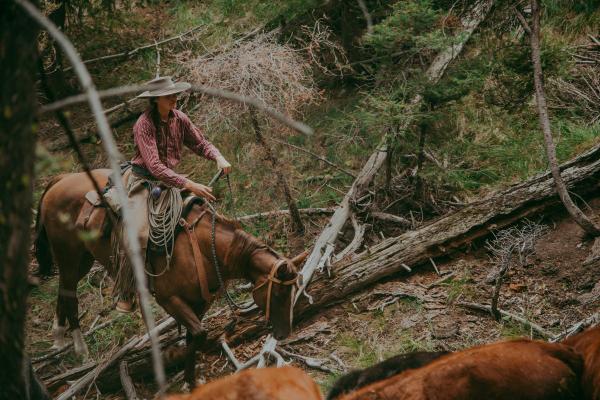
At the crack of dawn today, I discovered myself a victim. I recognized this feeling. It was a weaker manifestation of the same sensation I had when I discovered that several antique firearms I had on display on my wall in the ranch house had been stolen. It wasn’t until the perpetrator was apprehended, confronted and given the opportunity to make his wrong right that the feeling began to evaporate.
My 8000 foot morning scouting trip was to find more green forage in the cooler temps of the forested peaks for Alderspring beeves. I had left behind the crew of daughters Melanie and Linnaea and summer conservation rider Renae as they cooked breakfast in camp and gathered their horses for the day. It was our first night in Camp 6, and it was one of the highest camps we had been to so far this year, an attempt to escape the unrelenting effects of the sun and summer heat on our range grasses.
I paused for a breather on the broken ridge a few thousand feet above Camp 6, also known as the Narnia camp (named by a crew several years ago for the apparent resemblance to the otherworld). The sun had just emerged from the horizon, and the ridges surrounding mine were aglow with the first light of day. Looking southeast, the entire Pahsimeroi Valley stretched to the horizon, culminating in the snowy crest of 12,600 foot Borah Peak, the highest point in Idaho. It was over 50 miles away.
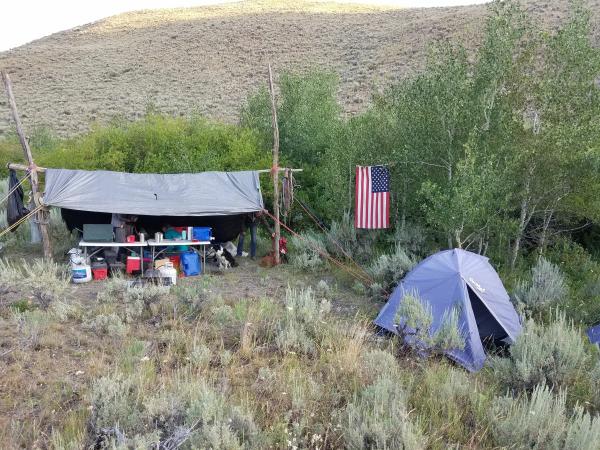
I rode a little further to a meadow that I recalled from years past that had a clear pond in the middle of it. It was along a buck and pole fence constructed out of the plentiful lodgepole pine and fir trees that comprised the forest around the meadow. The fence marked the ridgeline boundary between our grazing lands and my neighbors. I knew that there would be some fence maintenance required on that ridge because shifting deep snows often knocked pole fences over.
As I broke through the trees to the lush green meadow I was expecting, I immediately halted. The tall wildflower studded and verdant carpet was gone. Instead were the browning stumps of grass eaten voraciously by someone else’s livestock. I continued my ride to the pond to find that my clear and pristine water was stirred up to a muddy consistence and half empty.
I knew I should have fixed the fence earlier! I swung over to look at the fence, and over half of it was on the ground. The neighbor’s cows had beat me to some of the best grass of the year. I felt ripped off.
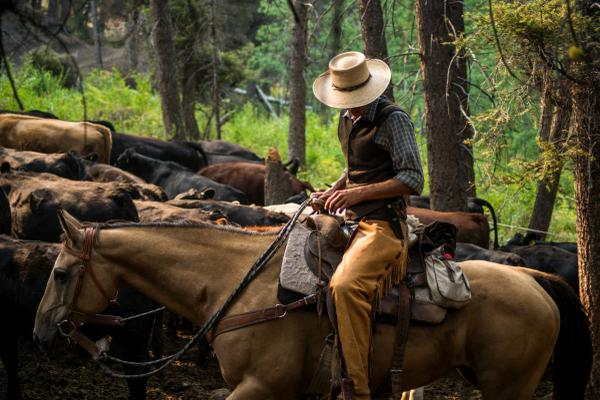 Meanwhile, as I started raging, the instinctual area of my brain was trying to get a message through the fog of anger that filled my mind. I should have listened immediately; instead, I stalked around the torn up fencing and began to cobble it together.
Meanwhile, as I started raging, the instinctual area of my brain was trying to get a message through the fog of anger that filled my mind. I should have listened immediately; instead, I stalked around the torn up fencing and began to cobble it together.
Reality finally overcame my mental world. It started with a crashing sound in the nearby forest. It got my attention, and I stood silently, focusing in on where the destructive wrecking noises came from, squinting into the dark shadows of woods where the sun had not yet shown.
All at once, movement across the entire front of where forest met meadow, brown bodies erupted, tumbling out. Wild elk. Over one hundred noisily poured out into the meadow, voraciously grabbing green as they trotted through. It was several maternal family bands: they were cow elk with nursing calves at their side and the occasional spike or “raghorn” immature bull mixed in—in full velvet.
As my brain realigned to reality, I realized that they were my “interlopers” who were “stealing” Alderspring grass. I had ignored all the indicators that my mind muscle memory was ticking off the list of trail signs: I had been seeing, but not registering tracks (subtly distinct from that of bovine), droppings (completely different from bovine), and scent (musky and quite elky in nature). Sadly, often we too heavily rely on sight and ignore our other senses. In my defense, it was the end of the week, and I hadn’t gotten much sleep in cow camp the night before.
There simply was no bovine sign at all. It was all elk. Elk grazed, drank the pond to mud, and knocked down my fences. All legal, and fully within their rights.
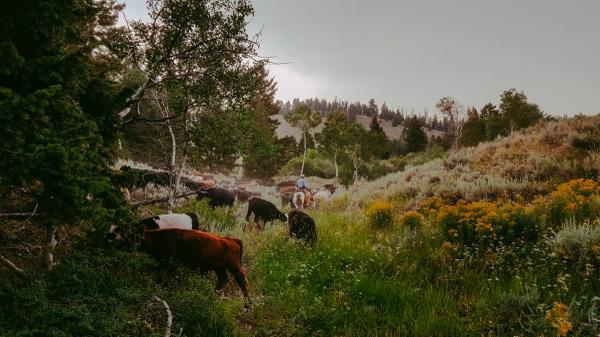
And here’s the irony of it: I didn’t mind it. They have their place here, and we share it with them. They are part of this landscape, just as the trees and creeks are. Besides, I’m always a little awestruck when I see elk in their natural state. They are indeed a regal animal, carrying themselves with head held high and proud; they are the noblemen denizens of the mountains. In addition, they are a telltale of the absence of wolves, at least for now. For them to be braving thick forest cover and adjacent meadows adjacent to thick forest reflects the security they feel.
And that’s good. It’s not saying we won’t deal with wolves at sometime this summer, but for the time being, the highly ranging wolf packs are not using our area. (For new readers, know that we are committed to non-lethal coexistence with wolves, and they are one of the reasons we camp out with our cattle all summer. Our simple presence deters most interaction.)
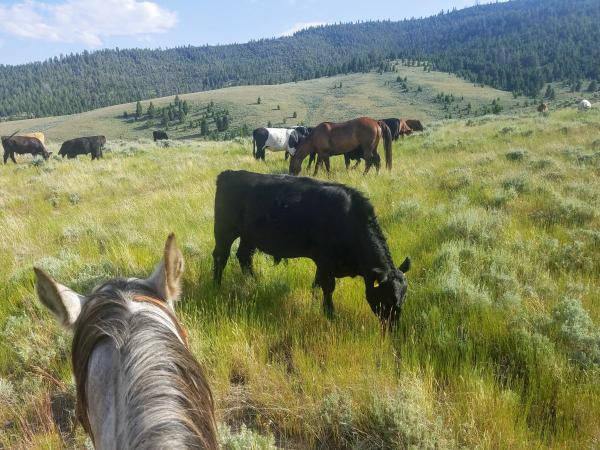
I fixed the fence as best I could with what materials I could scrounge from the knocked-down fence, and began to pick my way down the trail headed back down to Camp 6, back to the cool aspen dancing Narnia.
Anger evaporated. I would have to find another area to graze. I’m sure I will find it on 70 square miles; we always do, and cattle get their fill, while ranging across the country under our shepherding hand as we try to mimic the ancient movements of bison (and elk) in their natural landscape.
And that we do to be part of the ecosystem, like those elk that we share it with.
Happy Trails.
Glenn, Caryl, Girls and Cowhands from Alderspring.


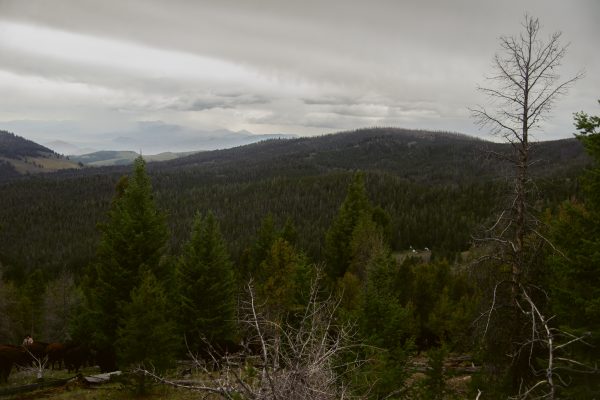

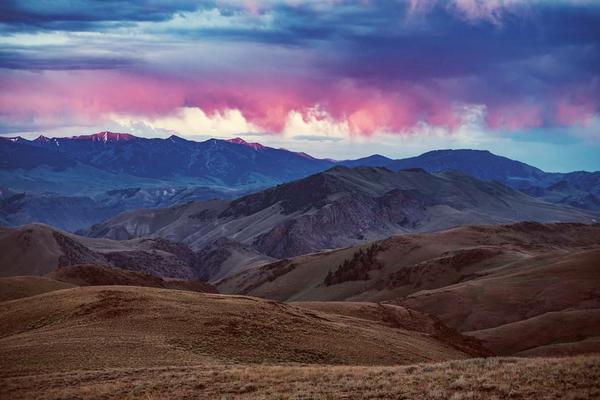


Leave a Reply